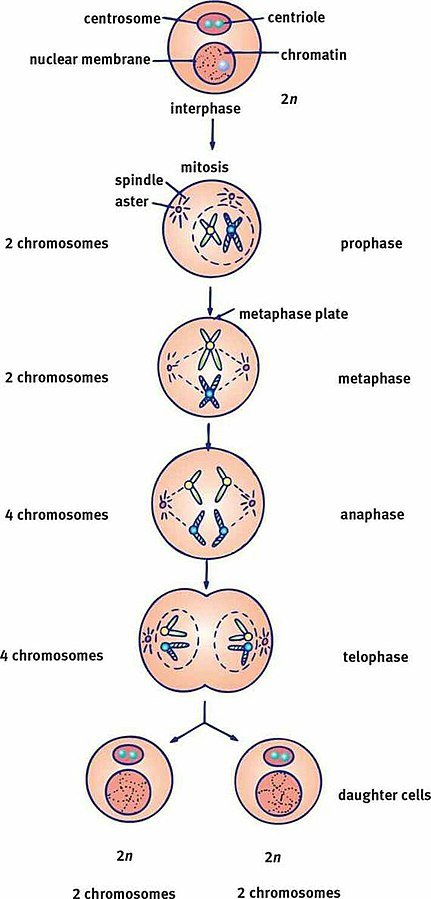Cell division
Cell division is the fundamental biological process essential for growth, development and maintenance of living organisms. Cell division ensures the accurate distribution of genetic material from parent to daughter cells. During the process of cell division, cells rapidly replicate and divide, playing important role in maintaining the stability and functionality of tissues and organisms. The cell division occurs by two mechanisms, one is mitosis and another is meiosis. In this article we will discuss about cell division including mitosis and meiosis.
Cell cycle
The eukaryotic cell passes through a series of stages collectively known as the cell cycle. Cell cycle consists of two gap phases as G1 and G2 and synthesis phase (S phase). The actual partition of genetic material occurs in M phase. The resting phase between two subsequent cell division is called as interphase. It comprises following phases.
- Resting phase (G0 phase): The cell is at rest, it neither divides nor prepares itself for the division.
- Gap 1 (G1 phase): The cell is metabolically active and grows continuously during this phase.
- Synthesis (S phase): The DNA replication or synthesis occurs during this stage.
- Gap 2 (G2 phase): Protein synthesis happens in this phase.
- Quiescent stage (G0): The cell does not undergo further division and enters an inactive stage. In this stage cell prepare itself for upcoming cell division.
The actual cell division occurs in the M phase. The cell division occurs by two mechanism one is mitosis and another is meiosis.
Mitosis
Mitosis produces two daughter cells which are genetically identical to each other and to the parental cell. It produces genetically diploid (2N chromosomes) with 2X DNA content. All eukaryotic cells replicate via mitosis, except germline cells which undergoes meiosis to produce gametes (eggs and sperms). There are four phases of mitosis as described below.
- Prophase: Chromosomes present in a pair of identical sister chromatids. Both sister chromatids are joined at centromere.
- Metaphase: In this stage chromosomes lined up at middle of the cell. They are pushed and pulled by microtubules of the spindle apparatus.
- Anaphase: In this stage sister chromatids gets separated from centromere and migrate towards the opposite end of cell.
- Telophase: In this stage chromatids accumulate at opposite end of cell and begin to decondense. The diploid nucleus appears in this stage.

Meiosis
Meiosis is the special sequence of two cell divisions which produces haploid gametes from diploid germline cells. After two successive divisions (with no additional DNA replication), 4 haploid gametes are formed with 1N chromosomes and 1X DNA content.
- Meiosis I: In this stage, pair of homologous chromosomes get separated. A special cell division reduces the cell from diploid to haploid.
- Prophase I: The separated chromosome pair exchange DNA to form recombinant chromosome. In this stage chromatid get separated from centromere and move to the end of the chromosome. Prophase I divided into five phases as, leptotene, zygotene, pachytene, diplotene and diakinesis.
- Prometaphase I: In this stage spindle apparatus is formed. The chromosomes get attached to spindle fibres by kinetochores.
- Metaphase I: The homologous pair of chromosomes arranged as double row along with metaphase plate. This arrangement is with respect to poles of the spindle apparatus is random.
- Anaphase I: The homologous chromosome moves to the opposite end of cell.
- Telophase I: The chromosome become diffused and the nuclear membrane reforms.
- Meiosis II: This is the last stage in meiosis type of cell division. The chromosomes get separated into two chromatids. The events of meiosis II are analogous to those of mitotic division but the number of chromosomes involved is half.
Summary
Cell division is one of the important biological processes which ensures the growth, development and maintenance of living organisms. There are two main types of one is mitosis and another is meiosis. Mitosis is a process in which single cell divides into two identical daughter cells. It consists of several stages, including prophase, metaphase, anaphase and telophase. Mitosis plays a fundamental role in growth, tissue repair and asexual reproduction. Meiosis is a specialised cell division process which occurs in sexually reproducing organisms. It involves two sequential division as meiosis I and meiosis II. It results in the formation of four non-identical daughter cells, each with half the number of chromosomes as the parent cell. Meiosis is essential for the production of gametes and contributes to genetic diversity through the shuffling of genetic material during the process of crossing over.
Frequently asked questions
What are the 2 types of cell division?
Cell division occurs in two types: mitosis and meiosis.
What are the 4 stages of mitosis?
Mitosis has 4 stages as, prophase, metaphase, anaphase and telophase.
How many daughter cells are produced in mitosis?
Mitosis produces two diploid daughter cells, with 2X number of DNA.
How many daughter cells are produced in meiosis?
Meiosis produces four haploid daughter cells, with 1X number of DNA.
For more regular updates you can visit our social media accounts,
Instagram: Follow us
Facebook: Follow us
WhatsApp: Join us
Telegram: Join us

1 thought on “Cell Division: Mitosis and Meiosis”